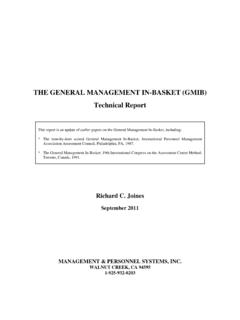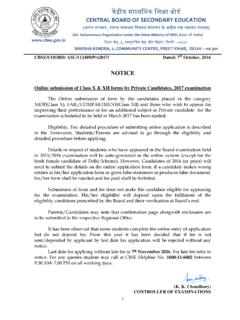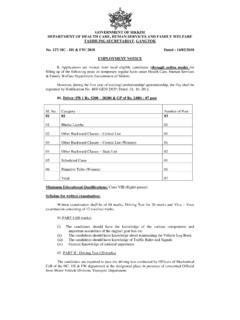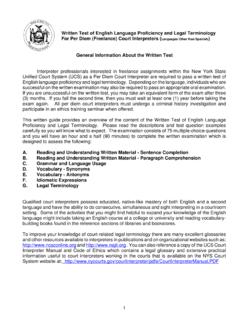Transcription of Civil Service System Passing Score: Using a score of 70 vs ...
1 Civil Service System Passing score : Using a score of 70 vs. 70%Richard Joines, PresidentManagement & Personnel Systems, Inc. Walnut Creek, CA 94595(925) 932-0203 Overview: Using an a priori Civil Service Passing score of 70% is not in keeping with sound testingprinciples. The purpose of this paper is to explain the psychometric issues that are involved, alongwith relevant testing and regulatory concerns, so that staff who find themselves in such asituation may explain to Civil Service Commissioners or others why such a rule needs to be changedto set a score of 70 as Passing , NOT a score of 70%.
2 Regulatory/Federal Concerns: The Uniform Guidelines on Employee Selection Procedures (1978)address the issue of establishing Passing scores on tests (see General Principles, Section 5H, CutoffScores), as follows:"H. Cutoff Scores. Where cutoff scores are used, they should normally be set as to bereasonable and consistent with normal expectations of acceptable proficiency within thework force. Where applicants are ranked on the basis of properly validated selectionprocedures and those applicants scoring below a higher cutoff than appropriate in light ofsuch expectations have little or no chance of being selected for employment, the highercutoff score may be appropriate, but the degree of adverse impact should be considered.
3 "This language focuses on two points. First, it is suggested that Passing scores (which are the sameas "cutoff scores") should generally be set at the level associated with minimally acceptableperformance on the , it is stated that practical issues may play a role in setting a Passing score that is higher thanthe level associated with minimally acceptable job performance ( , if you have so manycandidates relative to the number of positions to be filled that those below the higher cutoff havelittle or no chance of being hired, you may use the higher cutoff).
4 However, in choosing a highercutoff, the degree of adverse impact should be considered. By direct implication, the Guidelines aresuggesting that the Passing point should be lowered if the higher (practical) Passing score underconsideration significantly increases adverse impact. In other words, it would be unwise to raise thepassing score to a level just above a group of minorities or women. Failing these candidates wouldlikely be viewed as a conscious act of reader should note that the federal Uniform Guidelines on Employee Selection Procedures treatpassing scores as an important issue, with the language on adverse impact suggesting that passingscores should be established after the exam has been given.
5 The language in the Uniform Guidelinesis contrary to the idea that there is some a priori 70% correct standard that is always the score levelassociated with minimally acceptable job the Regional Psychologist for the Western Region of the Office of Personnel Managementfrom 1975-1980, I conducted reviews of the major government agencies under our jurisdiction,including the state governments of California, Arizona, Nevada, and Hawaii. In conducting thesereviews, I had internal guidelines to follow. Any agency Using a blind 70% pass rule would havebeen told to change it to conform to the requirements of the Uniform Guidelines.
6 There areadditional reasons of a technical nature that make it inappropriate to try to adhere to a rule that sayspassing is always 70%.For one thing, many tests are in use that simply cannot be scored on a percentage correct basis, suchas oral interviews, biographical inventories, personality instruments, and assessment exercises (in-baskets, report exercises, role-plays, and group discussions, etc). It doesn't make any sense to tryto fit these tests into a mold that claims a standard of 70% can be used to determine those whoshould pass these kinds of tests because these tests cannot be scored in such a the example of a typical interview rating System in which the raters use a 1 - 5 rating scale onthe factors being rated.
7 Suppose there are five evaluation factors ( , oral communications,interpersonal relations, job knowledge, etc). This would mean there is a total of 25 points on the testas a whole. In keeping with standard professional practice, the scale might look something like this: 12345 Poorly Minimally QualifiedVeryOutstanding Qualified QualifiedQualifiedCandidates who are rated "minimally qualified" are at the "2" level on the rating scale, and if thisis their score on each of the five factors, they total score is 10 points.
8 This is 40% of the pointspossible. Consider, however, what happens if we change the scale as shown below: 01234 Poorly Minimally QualifiedVery OutstandingQualified QualifiedQualifiedUsing this rating scale, a total of 20 points is possible (5 factors x 4 = 20). The person who is ratedas "minimally qualified" on each of the five factors would have a total score of 5 points; thus, thesecandidates would score only 25% of the points , something is wrong here because in both instances the candidates were rated one pointabove the lowest point on the scale, but the "percentage correct" changed from 40% on the first scaleto 25% on the second scale.
9 You should be asking yourself, "What's the trick?"The answer is that neither of these scales represents measurement on what is known as a ratio ratio scale is one that has an "absolute" zero. Absolute zero, in psychometric terms, is the pointat which "none" of the quality or property being measured in the United States is familiar with the Fahrenheit scale. Most of us have some directexperience with a temperature of zero degrees Fahrenheit. However, it is important to know thatthe Fahrenheit scale is not a ratio scale, and zero degrees Fahrenheit doesn't really mean absolutezero.
10 At zero degrees Fahrenheit, there is still warmth. Zero is warmer than 10 degrees below the Fahrenheit scale does not have an absolute zero point, it is not a ratio scale, and thus,we cannot say that 30 degrees is twice as warm as 15 degrees. We simply can't interpret ratios inthis manner ( , 30/15=2 but this cannot be interpreted to mean twice as much heat). In order tomake such statements, your scale would have to be a "ratio" scale that has an absolute the Fahrenheit scale, absolute zero isn't reached until you get to -459 degrees. That is the pointat which there is no heat.








